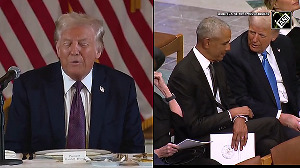Pakistan with about 60 nuclear warheads; primarily targeted towards India, is continuing production of fissile material for weapons and adding to its weapons production facilities and delivery vehicles, a US Congressional report has said.
The latest report by Congressional Research Service -- a research wing of the US Congress that prepares reports for Congressmen - has confirmed the recent statements and media reports that Pakistan was expanding its nuclear arsenal.
'Pakistan's nuclear arsenal consists of approximately 60 nuclear warheads. It continues fissile material production for weapons, and is adding to its weapons production facilities and delivery vehicles,' said the report titled 'Pakistan's Nuclear Weapons: Proliferation and Security issues', which was issued late wednesday night for media.
Admiral Mike Mullen, Chairman of the US Joint Chiefs of Staff, at a Congressional hearing on May 14 had confirmed that the US has 'evidence' that Pakistan is expanding its nuclear arsenal. Also, a similar report was published in The New York Times early this month.
Pakistan stores its warheads unassembled with the fissile core separate from non-nuclear explosives, and these are stored separately from their delivery vehicles, it said.
Pakistan does not have a stated nuclear policy, but its 'minimum credible deterrent' is thought to be primarily a deterrent to Indian military action.
'Deterring India's nuclear weapons and augmenting Pakistan's inferior conventional forces are widely believed to be the primary motivation for Islamabad's nuclear arsenal,' the CRS said.
The report further states that Islamabad gained technology from many sources, including uranium enrichment technology from Europe, blueprints for a small nuclear weapon and missile technology from China.
Pakistan's nuclear warheads use an implosion design with a solid core of highly enriched uranium (HEU), about 15-20 kg per warhead and 'Islamabad continues to produce about 100 kg of highly enriched uranium for weapons every year,' the report said.
Referring to expansion of Khushab plutonium production reactor -- by adding two additional heavy water reactors with Chinese help -- the report said 'the continued expansion of the complex and production of weapons materials could indicate plans to increase its nuclear weapons arsenal in the near future'.
The CRS reports that even as Pakistani officials have said that they have already determined the arsenal size needed for a minimum nuclear deterrent and they will not engage in an arms race with India, all indications were otherwise.
Mullen also confirmed that the US has 'evidence' that Pakistan was expanding its nuclear arsenal and construction of additional nuclear reactors were a pointer in that direction.
The CRS said that Pakistan has pledged no-first-use against non-nuclear weapon states, but not ruled out first-use against a nuclear-armed aggressor that attacks Pakistan for example, India.
This ambiguity serves to maintain deterrence against India's conventional superiority. Others argue that keeping the first-use option against New Delhi allows Islamabad to conduct sub conventional operations, such as support for low intensity conflict or proxy war in Kashmir, while effectively deterring India at the strategic level.
'Pakistan has reportedly addressed issues of survivability through second strike capability, possible hard and deeply buried storage and launch facilities, road-mobile missiles, air defences around strategic sites, and concealment measures,' the CRS said in its report.






 © 2025
© 2025